AMD's Radeon HD 5670: Sub-$100 DirectX 11 Starts Today
by Ryan Smith on January 14, 2010 12:00 AM EST- Posted in
- GPUs
Power, Temperature, & Noise
As a note here, since NVIDIA does not offer a reference GT 240, we’re using our Asus 512MB GDDR5 GT 240 as our reference 240. It does have a dual-slot cooler, so the cooler is not directly comparable to the blower on the 5670.
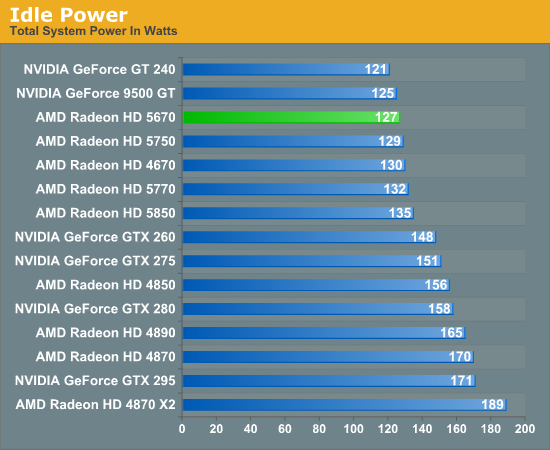
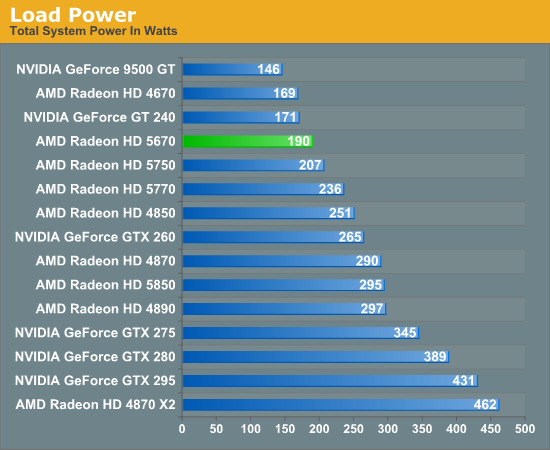
The one thing AMD can’t quite best the GT 240 at is idle power. Here the GT 240’s sub-10W idle means the 5670 idles slightly higher. With that said it’s the 3rd lowest card of all time, behind only the GT 240, and the significantly slower 9500 GT.
Load power paints a different picture however, and this is where the concept of a “power virus” pokes its head up again. The 5670 has a lower TDP than the GT 240 according to the specs published by AMD and NVIDIA - at 61W and 70W respectively - and we have no reason to doubt these numbers. But here the load power of the 5670 is much higher, by just shy of 20W. You’ll notice here that the 4670 is also much lower in spite of similar specs – all of this leads us to believe that the other cards are throttling themselves some as compared to the 5670, whose VRM protection features let it run away compared to these cards. Compared to the 5750 the data is correct, so that makes a better reference point than the GT 240 or 4670.
Accounting for these quirks, the 5670 should be between the 3rd and 2nd lowest power consuming card that we have on-hand.
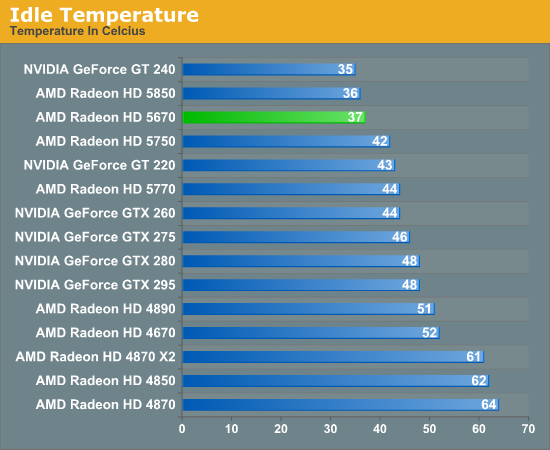
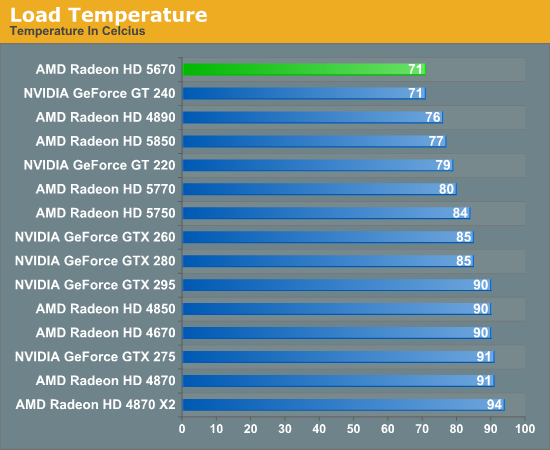
Less power usage leads to less heat, and in this case this means the 5670 once again trails the GT 240, which benefits from said lower power usage and the dual-slot cooler on our specific card. It’s still the 3rd best card however, beating everything except said GT 240 and the remarkably cool 5850.
At load, the picture looks very good for AMD. Even though we’re using a dual-slot cooler, thanks to the low load power usage we’re looking at a tie for the lowest load temperatures we’ve ever recorded. The dual-slot GT 240 ties at 71C, and we’re several degrees from anything else. The results are particularly good compared to the 4670, which was an inferno at 20C higher in this test.
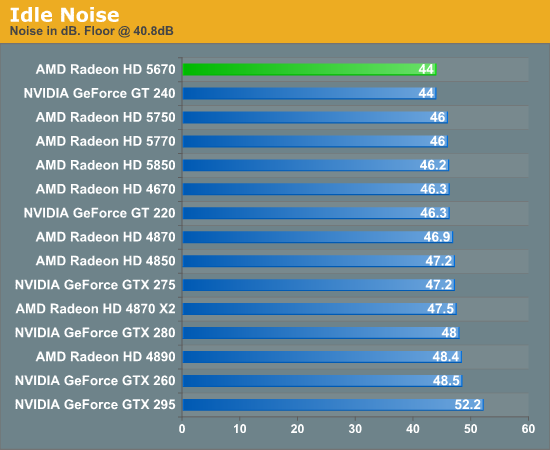
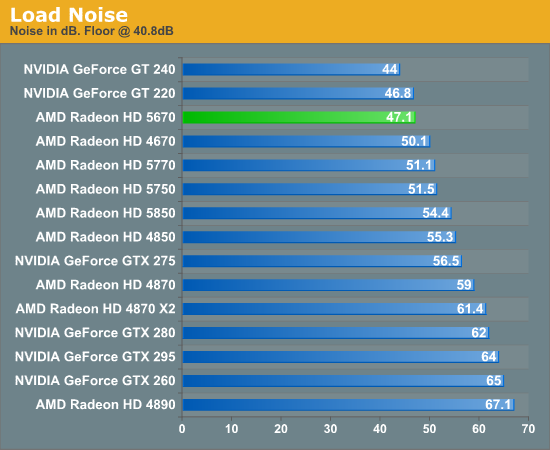
Finally there’s noise. As is the case with all of our other cards, the noise at idle is virtually indistinguishable from the noise generated by the rest of the computer.
At load the 5670 continues to be a quiet card, at only 3dB louder than idle. The only thing it falls behind here are the GT 220 and GT 240, both of which use dual-slot coolers and can afford the use of a larger, quieter fan. This is actually very impressive for a single-slot blower.
All of this data points to the 5670 making for a good HTPC card, certainly one as good if not better than the GT 200 series, and definitely better than the 4670. It’s cool and quiet, everything an HTPC card needs. However we’re more interested in where the 5500 series would place here – few HTPCs need this much rendering power, and with the 5500 series sub-50W power draw, it may be an even better choice.










73 Comments
View All Comments
Slaimus - Thursday, January 14, 2010 - link
Another nice thing about it is that it makes an inexpensive triple-head card that does not need external power, even if one of the heads needs to be Displayport. Even a single link HDMI/DVI can still support 1920x1200.SlyNine - Thursday, January 14, 2010 - link
Is the 4670 you have in your comparison charts a 4670 with DDR3 or DDR2?Also any news on the mobile version of this card or the 5380 I've seen in alot of notbooks?
Ryan Smith - Thursday, January 14, 2010 - link
GDDR3.And I don't have any news on the mobile 5000 series. Nor is there a 5830 that I have been informed of.
Blahman - Thursday, January 14, 2010 - link
5830 is in the HP Envy 15.Ryan Smith - Thursday, January 14, 2010 - link
If it's in a laptop, then it's going to be a neutered Juniper. The Mobility series is always a part down, so a Mobility 5800 series part would be Juniper based.SlyNine - Thursday, January 14, 2010 - link
I'm sure I seen it in 2, including the Envy15, Perhaps I shouldn't have said "alot".But it would be good to have a review comparing the mobile solutions out there. Not to mention the throttling problems in some notebooks.
I'd love to see Anandtech do a review of the problems the Dell XPS 16 w/ Core I7 has. On A/C and only on A/C it cuts the multiplier to 7 and then uses a clock modulation. Clock modulation tells the cpu to only do work certain cycles, so you can have as many as 75% of your CPU cycles going to waste.
The end result is a Dell 1645 Core I7 running at the equivalent of 300mhz.
more info at this forum : http://forum.notebookreview.com/showthread.php?t=4...">http://forum.notebookreview.com/showthread.php?t=4...
Full story here, and just for the record, Id be willing to let Anandtech borrow my 1645 to test if Dell doesn't fix it with this next BIOS update, which I don't see how they can 90watt AC is simply not enough.
WT - Thursday, January 14, 2010 - link
I read through that thread yesterday. We support 50+ Dell e6500 laptops that have been problematic in other ways besides throttling, but it was nevertheless interesting to read and pass along to my fellow IT co-workers.JarredWalton - Thursday, January 14, 2010 - link
I've looked at the thread and sent Dell an email asking for comment. It's important to remember power supply (power brick in this case) efficiency, so if the brick can output 90W and it's only 75% efficient (which is probably higher than what it really achieves), power draw at the wall of up to 120W might be achievable without the need to throttle. So, it's possible that a BIOS update will indeed address the problem, but let's not jump to any conclusions just yet....I'd also say that if you're using FurMark to achieve the throttling, find something else instead. FurMark really pushes the envelope and many consider it a power virus. I understand others are saying it occurs with regular games, which is obviously a much bigger issue than with a test program that doesn't represent a real-world workload.
Anyway, if you really want to send us the laptop for testing, why not do the testing yourself and use that as the basis for an audition to AnandTech? If you go that route, I would make sure you really investigate when throttling does and doesn't occur, look at the various power profiles and try tweaking those, etc.
As a side note: with Win7 I noticed on at least one laptop that using the "passive" cooling profile caused video playback to stutter, and setting it to "active" fixed the problem. There are so many variables that you can never know 100% what might be causing a particular problem.
SlyNine - Sunday, January 17, 2010 - link
Jarred thanks, I'm going to take you up on that and currently I'm doing a write up on the XPS 1645 w/ RGB. I would love any suggestions or if you would like me to include anything please send them to SlyNine@hotmail.com with the subject: XPS 1645. If anyone knows any tools other then throttle stop to monitor the CPU modulation that would also be helpful.SlyNine - Thursday, January 14, 2010 - link
Yea I don't use FurMark at all, in fact I made a post recommending them not use it.With just UT3 nothing else going on the multiplier hits as low as 7 and with the brightness up halfway the modulation kicks in bringing the CPU down to 25%, that's only 25 cycles out of every 100 that's willing to do anything. Even just doing a Prime 95 run the multi is below 10, correct me if I'm wrong but isn't it supposed to be around 13?
But thanks a TON Jarred for acknowledging this, If a high profile sit like Anandtech did a story on it I'd imagen that dell would have to respond. Really this is an Amazing laptop otherwise (other then this line I have threw my screen but obviously that is covered by warranty.)